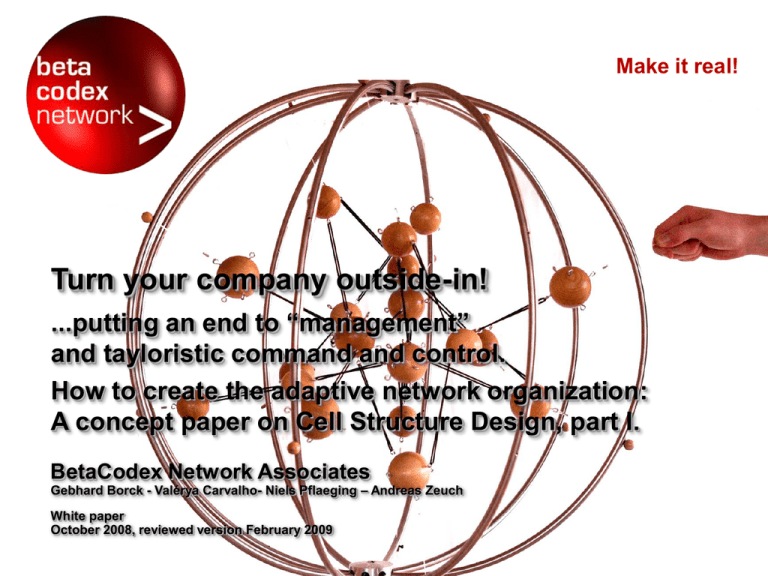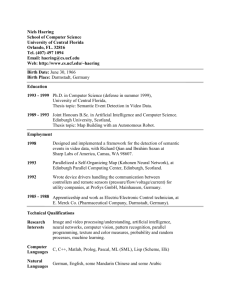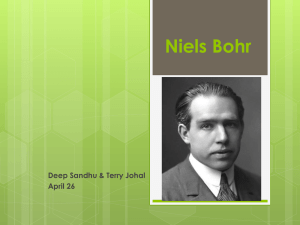Organizational Design
advertisement

Make it real! Turn your company outside-in! ...putting an end to “management” and tayloristic command and control. How to create the adaptive network organization: A concept paper on Cell Structure Design, part I. BetaCodex Network Associates Gebhard Borck - Valérya Carvalho- Niels Pflaeging – Andreas Zeuch White paper October 2008, reviewed version February 2009 Think about organizational design. You are now probably conjuring up images of managers or management consultants shuffling boxes on an organization chart. Right? Organizational Design: The Lost Art. Well, that kind of ”corporate restructuring exercise“ hardly deserves to be called organizational design. The topic of effective organizational design transcends disciplinary lines. That´s why it is not effectively taught at business schools, that´s why there is little decent research in the topic, that´s why nobody in an organization, except ”top management“, dares to touch it. To design an organization effectively, you need to understand business models, organizational behavior, information technology, accounting, and leadership. In recent years, writers and thought leaders have coined a dizzying array of buzzwords to help managers design organizations. There is talk of networked organizations, boundaryless organizations, virtual organizations, learning organizations, federalist organizations, wiki organizations, starfish organizations, and the like, to name only a few. But if you actually read and study these works, you will share our frustration. With few exceptions, most writing on this topic is either utopian, or limited to certain types of organization, or is shallow in a sense that it offers advice that has no theoretical underpinning. The utopionans rail at the stifling nature of hierarchy and extol the virtues of “organizations without structure“: self-organizing work, networks, and employee empowerment will, they argue, miraculously drive out command-and-control empires. The other set of books and articles offers design choices supported by detailed lists of pros and cons. Yet these analyses quickly prove to be unsatisfying. Lists of tradeoffs and considerations fail to provide a clear sense of direction. When you finish a chapter, it is never clear what exactly organizations should do – choices abound, but no rationale for decision and no convincing theoretical underpinning is given. The BetaCodex, in contrast, presents an integrated theory that gives clear direction about how to design organizations and how to make it fit with management processes, and leadership. To outline how the new breed of organizational design works, this paper offers a tour de force disciplines, and 3through many of the conceptual frameworks that BetaCodex Network through white paper –different Decide to © Niels Pflaeging & Gebhard Borck – All rights Some considerations about organizational design first. Organizational design is a means to an end. Not more, not less. And that end is to create and maintain an organization capable of achieving sustainable competitive success in a dynamic and complex world.* In this context, it is important to remember: There is more to organizations than design – so to bring the design to life, you need to create a coherent whole including values, language, communication, leadership style, processes, etc. There is no single right design for your organization – but your design process should be based on robust design principles Organizational design is an evolving, iterative process – which only feels messy and complicated if the principles that are applied are messy, and if important assumptions are not made explicit. The design you will come up with at first will not last forever, or even for long – because you will learn more and more about different design options and learning loops will inevitably occur. * This is a claim that is closely related to the BetaCodex Network´s mission. BetaCodex Network white paper – Decide to 4 © Niels Pflaeging & Gebhard Borck – All rights The notion of dividing an organization into functions, and then departments, is fundamentally flawed. But what is the alternative? Why should we look for an alternative way of building and governing organizations? The notion of dividing an organization into functions, and then departments, is fundamentally flawed. Dividing a firm like that, you actually impede work flow, build organizational territories, and drive out initiative and entrepreneurial thinking. But companies have done exactly that for ages. Organizations today are crippled by tayloristic thinking and division between functions. Taylor´s idea of separating thinking from execution – like the assumption that responsibility for control and coordination should be located one level above from where the work is actually performed – have created immense misalignment with today’s critical success factors. These problems have been laid out in detail by the BetaCodex movement since its foundation (then coined “Beyond Budgeting”) in 1998, and also by a fair amount of management thinkers and scientists. For further reference on the problems with tayloristic management, see the BetaCodex Network´s website. The alternative to taylorism, however, has not been that clear, until recently. And knowledge about how to transform tayloristic organizations into post-tayloristic orgnizations, which are capable of reinte-grating thinking with decision-making and execution, has been patchy at best.* So if we want to depart from the current standard of corporate modern-world “slavery“, based on now obsolete thinking, we need two things. First, we need new mental models to build and govern 21st century organizations. And we also need new, systemic models for change, in order to enable wide-spread transformation of organizations. The problem, overall, is not that people were not fit for accelerated dynamic and more fierce competition. We clearly hold a different view: that, instead, organizations as they are designed today, are not fit for the capabilities of the human beings that work inside them. The tayloristic “machine organization” is doomed, in an age of dynamics and competition. The tayloristic model now has become an immoral choice as a blueprint for organizational design. Why? Because, quite simply, it stands in the way of their people to fulfil their potential, and furthermore because quitewhite recently, the tovision and practical6 road-map to an alternative model has emerged. BetaCodex Network paper – Decide © Niels Pflaeging & Gebhard Borck – All rights Outlining the ‘industrial age’ model and its pitfalls “command and control“ “keep on track” strategy Fixed performanc e contracts control BetaCodex Network white paper – Decide to 7 • • • • • • • • • Too centralized Too inward-looking Too little customer-oriented Too bureaucratic Too much focused on control Too functionally divided Too slow and time-consuming Too de-motivating … From the film ‘Modern Times’ with Charlie Chaplin, 1936 © Niels Pflaeging & Gebhard Borck – All rights Recurring themes in organizational design that any robust design model must address Clarify ownership Define resource and value creation flows Allocate authority and power Embed governance Assure coherence and cohesion … Create robustness for growth and evolution BetaCodex Network white paper – Decide to 8 © Niels Pflaeging & Gebhard Borck – All rights Common alternative ways to visualize organizations – according to Henry Mintzberg Oranizations as “pyramids and chains” • Process chain strengthens the vertical chain • • Organizations as “hubs” • The points of focus are hubs: it's them who • • Organizations as “networks” attract, emit and move people, things and information Less focused on sequential activities Example: Hospital - the patient as focal point • Some organizations naturally don't have a centre • • Source: Mintzberg, 2004 BetaCodex Network white paper – Decide to (hierarchy) Sustains centralization and heroic management: “The top manager as an important person, removed from operations, taking decisions based on analyses and calculation” Imagine a hospital, a laboratory or a project– they simply don't work this way! (e.g. labs, or project teams...) They are networks with free interaction, embedded in collaborative relationships that work in any direction It's not a model “without structure” – it just follows another logic. One that is not focused on activities or © Niels Pflaeging & Gebhard Borck – All rights 9 managers. How to leave taylorism behind… Highly devolved organizations, as opposed to command and control organizations, are not structured hierarchically. In fact, since hierarchies don’t accept any other rulers but “top management”, or “bosses”, radical empowerment based upon the decentralization of decision-making is not compatible with structures based on power relationships and hierarchy. Although it is well-known that many organizations are factually ruled not by formal, but by informal networks, the common way to make teams act responsibly is still to give some of the organization´s members a “commanding”, or “managing” position. BetaCodex organizations, on the other hand, want to achieve something entirely different: They want everybody in a company to think, to be and act responsible, in order to increase the value and wealth creation. Therefore, a BetaCodex organization does not “believe” in hierarchy. It believes in empowerment and in the capabilities of its people. And the bestknown and successfully practiced route to empowerment is to turn the organization into a network of interrelated cells. A cell structure (as opposed to a design based on “departments” and “functions”) is capable of interacting situationally, in more diverse ways than functionally divided hierarchies. Even more so, it doesn’t need commands to be controlled – it can be controlled and governed just through “market pull”. Other control mechanisms that make sense within a decentralized cell structure are self-control, “peer pressure”, cultural control inspired by strong shared values and culture, as well as a far higher level of internal and external transparency than is common in the tayloristic management model. Overall, by creating a network of these cells, and by making use of people´s full potential, business is being turned as simple and as BetaCodex Network whiteas paper – Decide to © Niels Pflaeging & Gebhard Borck – All rights straight-forward executives always dreamt 10 it would be. So who has actually done this, in practice? Eric Schmidt, CEO of Google, once humorously coined it “the borg”, referring to the extraterrestrial race on Star Trek. Dennis Bakke and Roger Sant, of US-based energy firm AES, dubbed it “the honeycomb”. Ricardo Semler of Semco from Brazil calls it the “circular organization”. Terri Kelly, CEO at W. L. Gore, talks about the “lattice organization”, a concept the company has applied since the 1960s. In the past, others have called it “the onion”. Ultimately, they are all talking about the same: A new way of thinking about organizations without a common hierarchy. As one can see, we are still far cry from reaching a consensus on wording with regards to the “alternative” organizational model that will succeed tayloristic command and control pyramids. Schmidt, Bakke, Semler, Kelly and others are all describing the notion of an organizational structure that is a neither based on power relationships, nor on hierarchy or functional division. These organizations have built devolved “sense and respond” networks. An example: Semco's Survival Manual, the company's only written set of principles, claims that: “Semco does not use a formal organizational chart. Only the respect of the led turns someone into a leader. When it is absolutely necessary to sketch the structure of some part of the company, we always do it in pencil, and dispense with it as soon as possible.” Much like Semco, several other BetaCodex pioneers, such as Guardian Industries and Handelsbanken, do not have an org chart at all, and they get along with three layers of hierarchy only. That said, the pioneers still have some hierarchy, though usually not more than three layers, regardless of their size. In their organizational design, thus, “hierarchy BetaCodex Network white paper – Decide to © Niels Pflaeging & Gebhard Borck – All rights 11 doesn´t matter“. It is perceived as a rather trivial fact, and one that is not really relevant for The challenge: From hierarchy to network structure. But we need methodologies for redesign and for creating the change! Traditional model (centralized functional hierarchy) New model (decentralized leadership network) Changing leadership and structure • “Bosses” rule! • Top-down command and control • Top management is always in charge • Centralized leadership BetaCodex Network white paper – Decide to • “The market” rules! • Outside-in sense and respond • Front-line teams are always in charge • Devolved leadership 12 © Niels Pflaeging & Gebhard Borck – All rights What is new about this? Although previous concepts have failed to fully explain cell structure as a business organization structure, there is still a lot we can learn from other thinkers on the subject. One of the most significant contributions to the field of organizational design probably comes from systems theory. Stafford Beer, the father of British systems thinking, who died in 2002, laid the foundations of the Viable Systems Theory – a theoretical concept that lacks practicality, but that has inspired many within the field of organizational development anyway. Dirk Baecker, a follower of German systems theorist Niklas Luhmann, convincingly points to the systemic incoherence between general knowledge of systems and what happens in business organizations. But even though systems theory explains lots of the phenomena that occurr, within firms, the advice of Baecker and others has been insufficient for practitioners with a desire to truly transform their organizations. Other theorists have explained important elements of an alternative model, but invariably failed to describe a coherent theory that would work for any company, or the consequences that come with implementing it: Most scientists, for example, have ignored the impact of steering processes, such as performance targets, planning, and compensation, on organizations. Even worse: Most leading thinkers partially remained within the boundaries of the old, tayloristic mindset with regards how business organizations have to work and be led. Charles Handy wrote about what he calls the Cloverleaf Organization, based on his observations about the individual and his responsibility in society, and the effects of that will be seen in business organizations one day. Henry Mintzberg made promising attempts at deriving conclusions from different “typologies” of organizations. Jay Galbraith developed what he called the “star model” of the organization, and recently, experts like Thomas W. Malone have been talking of organizations as “democracies”, “free markets”, or “loose hierarchies”, in which “no direction takes place and decisions are met at the front lines”. But one might ask, if ”front line”, “democracy”, or ”loose hierarchy“ aren´t rather13feeble concepts to© Niels be applied in realBorck life.– All Again, BetaCodex Network white paper – Decide to Pflaeging & Gebhard rights Why have so few organizations adopted a networked design? Not surprisingly, maybe, some of the best-understood network organizations of the past have come from the realms of the non-profit sector. As success and impact there depends, primarily, on volunteers that resist to “being managed”, convincing alternatives to “management” have always been a standard there. Many experts have described key characteristics of organizations like the WWF or the international boy scout movement, as proof that cell structure organizations can actually work. But is the same possible in the profit sector? Attempts on decentralized organizational models made by previously traditionally organized firms often could not meet the expectations. A high-profile case from the 90s was ABB - but their much lauded “matrix” organization soon went into decline. And for good reasons. Other transformed organizations have fared much better, as they chose more coherent ways of working, ways that were firmly rooted in more radically different mental models. Surprisingly, though, some firms with notable competitive success that abandoned tayloristic management long ago have never been recognized as network structures. A few of these firms have succeeded in building and sustaining a “decentralized network” structure over the course of many decades, as is the case of W.L.Gore, Toyota and Handelsbanken. But although the evidence is there, running a profitable cell network actually is seen as an exotic achievement of some exceptional leaders like Gore. Neither organizational theory, nor management science have been able to fully describe the principles of such structures, or have formulated a decent road map towards creating this kind of innovative design. This is about to change now. We will argue that, based on the 12 principles, or laws, of –the BetaCodex, it is possible to build a high©performance cell network for BetaCodex Network white paper Decide to Niels Pflaeging & Gebhard Borck – All rights 14 Organizational evolution: Typical phases within the lifespan of an organization, according to systems thinking Cybernetics rightly states that organizations have much in common with living organisms. In the same way in which organisms evolve through different stages throughout their lives, so do organizations typically change over the course of their existence. Systems theory has added to this a concept which relates intimately to what we call transformation. Organizations, in this view, typically begin their lives consisting of very few people, and in a “Pioneering Phase“, which is characterized by a high level of entrepreneurship, informality, autonomous and improvised decision making. There is little “structure“ here. A pioneer organization may feel chaotic- but a certain amount of chaos seems normal to every start-up, doesn´t it? However, as an organization becomes successful and grows, sometimes very quickly, new forces start to apply: There is a pressure to “professionalize“, to create a more formal structure, to hire specialists, to implement systems, to standardize proczesses and to do lots of “planning“. In this “Differentiation Phase“, hierarchy, functional division and departmentalization increase strongly, decision-making becomes more centralized, and rules and processes start to substitute improvisation and freedom to act. Though perceived as a blessing by many, differentiation is also always accompanied by the death of the organization´s more entrepreneurial founding, or pioneering culture. The place becomes “less fun“, in order to become more orderly. Many of us have seen this happening to organzations, and we have often observed the loss of entrepreneurship that comes with differentiation. Most organizations remain forever in the tayloristic paradigm. Few have so far escaped the differentiation trap, actively moving towards what we may call the “Integration phase“. Integration means applying a thinking that turns “large“ organizations into small, functionally integrated mini-firms, which can act with great independency and decision-making power. A visualization of the “phase concept“ is shown on the following page. As noted, few organizations firms have actually made this transformation. Within the BetaCodex research since 1998, we have identified a couple of notable and diverse BetaCodex Network white paper –however, Decide to © Niels Pflaeging & Gebhardexceptions, Borck – All rights 15 Who should “integrate” – and how does this concept relate to an organization´s evolution? This is where you should be! Evolution Integration within the decentralized phase model (culture of empowerment and trust) Transformation through radical decentralization of decision-making Sustaining and deepening of the decentralized model, through generations Differentiation Stagnation phase within the tayloristic model Low degree of Bureaucratization decentralization/ through growing hierarchy empowerment and functional differentiation Pioneering phase High degree of decentralization/ empowerment Foundation BetaCodex Network white paper – Decide to Time scale: organization's age 16 Several decades old © Niels Pflaeging & Gebhard Borck – All rights What makes the difference? Instead of centralized functions and departments, BetaCodex organizations have a lean and organic network of independent teams, or cells, which each work as fully accountable business units, or profit centers. To create a network of cells, however, you will have to fundamentally change the way you have thought about organizational structure. You will apply “functional integration” – as opposed to functional division, practiced by tayloristic organizations. This sounds easier as it is: Because our brains are astonishingly hard-wired into the notion of funcational division. You may notice that forther on. You will create a structure in which there is control in the forms of transparency, “market pull”, self-control, and peer pressure – as opposed to control through hierachy ad management staff. Cells themselves are accountable for results – not managers managing the team externally, or managers within the cell. This requires, first and foremost, a massive change in thinking. You will build individual cells that consist of permanent teams, of (temporary) project teams, or of ad-hoc and voluntary task forces. Though not at all common in traditional, functionally divided command and control organizations, teams based on voluntary participation can be highly effective and enthusiastic, as several of our case studies show. A networked cell structure has a lot in common with living organisms, as we saw before. Cell division is a common feature as well. It happens both in organisms and in networked organizations. Organizations of the new kind share the belief that a single cell should never outgrow a psychologically sound size that can grant high-trust communication among team members. Consequently, in cell network firms, once a team expands too much, this team gets divided “as needed”. This kind of cell division can be found at places such as AES, Aldi, Handelsbanken, Dell and W.L. Gore. Maximum cell size defined ©byNiels anPflaeging individual firm may vary BetaCodex Network white paper – Decide to & Gebhard Borck – All rights 17 greatly from industry to industry, and it varies among the case examples. W.L.Gore's unit size, How is life within a “network cell” different from working in a hierarchy? Generally speaking, single cells within a devolved network do not entail highly specialized people, but mostly generalists who share the workload flexibly among themselves. Furthermore, traditional tayloristic job descriptions focusing on an individual are displaced by role descriptions for entire teams, which focus on the responsibilities that have to be assumed by individual cells. These roles are often juggled with among team members, which means that “role rotation” is very common here. In order to allow for this flexiblity, generalistic talents of people are more appreciated in networked organizations, as opposed detailed technical knowledge, which is typically (over)valued in tayloristic organizations: Here, organizations sadly classify their people by their work, or job descriptions - not by their talents or abilities. In order to make a devolved network become real, thinking about work and performance have to undergo a deep transformation. In a single cell, employees have to be entrepreneurial thinkers and doers, whereas managers in these structures serve as advisors or keepers of shared values and principles. Their role extends to not more than to steward the organization. In the words of some of the pioneers, this means being a “catalyst” (Ricardo Semler) or an “enabler” (Vineet Nayar). Managers in their traditional role as commander, inspector and executor are not needed in a networked structure, but there are roles traditionally filled out by managers which can be assumed by single persons or by different persons in the cell´s team. The lead can be and is taken by everyone who takes the responsibility to act for the team. Besides the need for people to assume the role of “temporary leaders”, there is a need for “new roles”, which are not common in tayloristic organizations, but which are vital for decentralized networks to sustain coherence and learning. The “professor” role: These initiate learning processes in the organization, in order to keep the cells prepared for current changes and keep them innovative. The “artists” role: Artists have the sense for symbolic gestures, signs and rituals in order to make, maintain and develop internal and external relationships as well as maintaining, keeping conscious and penetrating the organization repeatedly with the its principles, reason for –being, role: BetaCodex Network white paper Decide to values, identity and © Niels Pflaeging & Gebhard Borck – All rights 18 visions). The “anthropologist” Let´s take a look at the design principles for an alternative organizational structure. If you are somewhat familiar with the Beta Codex, then you already know them... BetaCodex Network white paper – Decide to 20 © Niels Pflaeging & Gebhard Borck – All rights The 12 principles of the BetaCodex are a full set of “design principles“ for the new structure. Principles Leadership Customers and responsibility Performance and freedom Processes Governance and transparency Goals and rewards Do this! Not that! Customer/Market focus Focus on who is boss Responsible decentral teams Centralized decision making 6 devolved High-performance culture related to market Aspirations inspired by the past leadership principles Autonomy and entrepreneurial responsibility Adherence to fixed plans Clearly defined objectives and values Imposed objectives Open and shared information Restricted information Goals related to continuous improvement Goals negotiated for fiscal year Rewards related to company results Reward local, fixed goals Compare performance against actuals Variations against fixed plans 6 adaptive management Continuous and inclusive dialogue and preparing Annual top-down planning Planning and process principles controls Resources on demand, driven by “pull” Resources and coordination Coordinate by dynamic, market-like interactions BetaCodex Network white paper – Decide to 21 Annual allocations Departmentalization © Niels Pflaeging & Gebhard Borck – All rights Design principles In this paper, we are using two main concepts: 1. The BetaCodex with its 12 laws as the design model. 2. The Double Helix Transformation Framework as the way to achieving, or adopting it. This is the first time, actually, that a coherent and full organizational model (BetaCodex) and an implementation model (the DHTF) come together in a single approach, thus allowing not only to develop a new organizational form, but also to sustain it. Having the right design principles is key to transformation. The reason for this is that, ideally, Design principles should be so clear and simple that anyone in an organization can understand and apply them at all times. The people in an organization themselves are the ones best suited to develop the new organizational structure. Consultants should only provide moderation and guidance in the process of shaping out the structure. For an organization to maintain an organizational structure that is not command and control, the new principles (or the new mental model) have to stick with people. BetaCodex Network white paper – Decide to 22 © Niels Pflaeging & Gebhard Borck – All rights The design principles of the new model Conventional management practice has ignored the importance of understanding principles before leaping into action. Usually, organizations feel pressured into adopting a new method because “everyone else is doing it“. Six Sigma, Lean, the Balanced Scorecard, Business Reengineering, or CRM are such methods. Typically, neither managers nor the recipients of such schemes can articulate the design principles that are driving the method. And usually the majority of organizational members don’t have a clear idea of why specific changes are being made and how such change will affect them. This is different with the BetaCodex. The codex employs a set of 12 design principles for the new type of organization. The design principles are not rigid rules, but instructive codes that shape our thinking about how relationships between people, roles, tasks, and responsibility should be structured. They (and their tayloristic counterparts) reflect deep cultural assumptions having to do with the issues of power, authority, control and value creation in organizations. Design principles are equivalent to a mental model that acts as a systemic framework for constructing organizations. The design principles thus get to the roots of how organizations should be structured to get the work done, and to achieve superior competitive performance, together. Because organizations are human and social creations, design principles provide the criteria – implicitly and explicitly – that guide the way we structure and lead organizations. It is important in BetaCodex Transformation to make the ”old“ set of design principles and the new one explicit. This way, the mental models of all members of the organization can change. The design principles are far more than just rhetoric – they go to the heart of understanding the BetaCodex Network white paper – Decide to structural logic that © Niels Pflaeging & Gebhard Borck – All rights 23 influence leadership underlying premises and the and behavior. How markets govern organizations “from the outside in” Periphery Center Information Decision Command Impulse BetaCodex Network white paper – Decide to Centralist command and control “collapses“ in increasingly complex environments Reaction 24 © Niels Pflaeging & Gebhard Borck – All rights Why “make-and-sell” business models, combined with “command and control” management, don´t fit anymore Classic 20th century organizations from the industrial age usually applied make-and-sell business models, which means that you develop products, produce them and then give the customer an incentive to buy them. High performance organizations today use a sense-and-respond approach, which applies an outside-in philosophy. Any organization can apply an outside-in sense-and-respond approach. Famously, Toyota and Dell have invented outside-in business models in their industries (cars and computers, respectively), submitting production to single customer orders or projects. Guardian Industries originated a similar business model for flat glass and mirror production, being the first company in the industry to sell directly to customers. Handelsbanken, dm drogerie-markt and Scandinavian retailer Ahlsell work from the branch outside-in. Southwest Airlines, AES and Semco, Egon Zender International and W.L. Gore work from single value creation streams or customer projects. The high performers of the 21t century are “managed” by market pull, not through inside-out command and control. Waste and even damage occurs if inside managers are interfering with the mechanism of “market-pull”. Every single person needs a free and clear view to the market forces that are driving the organization. BetaCodex Network white paper – Decide to 25 © Niels Pflaeging & Gebhard Borck – All rights Ways to organize for empowerment Hierarchical organization charts dissimulate the view that organization members “serve the boss”, or hierarchy. They thus stand in the way of the market forces, by making people look “up”, not “out”. In this way, hierarchies limit the potential of their members to serve the market. BetaCodex organizations, on the other hand, don’t “produce” without market pull. They actually make use of the pull from the outside in to energize and stabilize their adaptive networks of cells. That way, BetaCodex organizations use the somehow differing interests of the market forces like legislation, investors and customers to “manage” their networks of cells. There are different ways to organize for empowerment, which are all coherent with Beta principles. The different typologies can also exist in combination. Profit center networks (e.g. Handelsbanken, Toyota and scandinavian retailer Ahlsell) Multi-project organization or project orientated organization with temporary centers of project teams established instead of permanent profit centers Cross-organizational value creation networks between self-dependent cells Adopting a cell structure design is vital to making integration, or transformation work. Without this kind of concept, building an organization with little hierarchy and no command and control, is near-impossible. BetaCodex Network white paper – Decide to 26 © Niels Pflaeging & Gebhard Borck – All rights BetaCodex Network white paper – Decide to 27 © Niels Pflaeging & Gebhard Borck – All rights The building blocks of the devolved networked organization According to the systemic view of an organization, a devolved network consists of only four types of structural elements, which we will explain more in detail in this section. Understanding the role of each of these elements is key to designing a truly devolved organization. The four structural elements of the model are: 1. Spheres of activity 2. Network cells 3. Network strings 4. Market pull That´s it. Simple, isn´t it? So let´s take a look at these different structural elements. BetaCodex Network white paper – Decide to 28 © Niels Pflaeging & Gebhard Borck – All rights Building blocks of the networked organization I: “Spheres of activity“ - distinguishing the inside from the outside • Every organization operates within its own “sphere of activity”. Consciously or unconsciously. The sphere originates from the combination of an organization’s purpose and identity. This encompasses its business model, its shared values and principles, its brand proposal, its vision and mission. • Traditional command and control organizations frequently fail to make their sphere of activity explicit to its people and stakeholders. The sphere thus remains ambiguous to the involved parties within the system. Not so in pioneering organizations of the new model, which always have an extremely strong corporate culture, a clear value system and explicit boundaries. The pioneers have a need for a well-defined sphere, because their governance doesn´t rely on command and control, use of power, and fear. • In traditional organizations, consequences cause actions. In pioneering organizations, on the other hand, all acting is a consequence. • Defining the sphere of activity is a key ingredient of the case for change, BetaCodex Network – Decide toup in the transformation © Niels Pflaeging & Gebhard Borck – All rights 29 which haswhite to paper be written from command and Building blocks of the networked organization II: “Network cells“ – how they differ from functions & departments • Network cells integrate several functions, roles and duties, which would be traditionally separated into different departments, divisions and areas. A cell thus contains different functions and roles! • Network cells offer and sell products and/or services on its own, and only depend on its market in its decisions about them. • Network cells are customer focused, as they respond only to internal or external clients, not to hierarchy. • Network cells are held accountable by other members of the organization and are responsible for their own value-creation. Each cell has its own P&L statement. • Network cells apply the full set of 12 laws of the beta codex. BetaCodex Network white paper – Decide to 30 © Niels Pflaeging & Gebhard Borck – All rights Building blocks of the networked organization III: “Network strings“ - the communication and value creation links • Strings depict the connections between cells, • showing a high level of elasticity. Such conncections arise from several different kinds of interaction: Value creation flows from the inside out, Formal communication, and Informal networking. Internal markets and pricing mirror the value creation flow from inside-out: Cell networks practice internal payments, from the outside-in, to compensate for internal services. BetaCodex Network white paper – Decide to 31 © Niels Pflaeging & Gebhard Borck – All rights Building blocks of the networked organization, IV: “Market pull“ - the force that actually “manages“ organizations • Market pull is what connects the market with the organizations, and thus the outer part of the sphere of activity with the inner part. Whenever an external stakeholder of an organization “wants“ or “demands“, “orders“ or does something relevant to the organization, it originates market pull. • Market pull can be applied by customers wanting something, but also by shareholders demanding a compensation for their investments, or a bank demanding payback of a loan, or the state demanding the payment of taxes, or a competitor launching a new product. Market pull thus has varied sources. • In the real world, there is no such thing as “market pressure“. This might at first sight appear as a counter-intuitive claim. But if you consider organizations as operating within their own, self-defined Sphere of Activity, then markets simply cannot apply “pressure“. What markets really do is that they apply “pull“. They do this all the time. And pull is a powerful BetaCodex white paperactors – Decide pull. to © Nielsthings. Pflaeging & Gebhard Borck – All rights force.Network All market They stimulate32by pulling. They want The importance of “market pull“ Market pull comes with an interesting collateral. Because once market pull is accepted as a governing and energizing force, consciously and by all members of an organization, it is capable of turning management as an internal function unncessary. In fact, management has been outsourced to markets long ago. This happened when competition and dynamic change took over within the environments of our organizations. In consequence, any effort to “manage“ an organization from the top down today means making a painstaking, but ultimately fruitless effort to “steer from within“, or to internally duplicate “what actually manages us“. In other words: management these days usually means trying to do something internally that the market already does for toyou in a much better so in a& Gebhard more Borck relevant BetaCodex Network white paper – Decide © Niels Pflaeging – All rights 33 way, because it does Some guidelines to creating a working cell structure: What characterizes a truly networked organization • It gains stability and resilience not through power relationships, or through “resistance to pressure”, but through the “pull” that comes from the market outside. (Sounds simple? It is!) • It is transparent, through open information systems. • It shows its internal interactions in a simple manner, based on “market” and “pull” relationships. • It creates a shared understanding of the “inside” and “outside” relationships of the organization. • It doesn’t care about hierarchy, but about value creation streams, based on networking patterns. • It has the interconnections needed - not more, not less • It applies the full set of 12 BetaCodex principles. BetaCodex Network white paper – Decide to 34 © Niels Pflaeging & Gebhard Borck – All rights Comparing the models BBTN white paper – Cell Structure Design, part 2 35 © BBTN – Open Source Further recommendations for you. • Read part II of this white paper, which covers two real-world case examples that illustrate how the BetaCodex cell structure design concept has been applied in two industrial organizations from two different continents. One is an international technology firm, the other a customer-dedicated production plant. The paper also shows how to embed Cell Structure Design into the process of transforming an organization from AlphaCodex (“command and control”) to the BetaCodex, and how to avoid common implementation traps we have discovered in our work with clients. • Turn this paper into a starting-point: Give us feedback on this series of papers! We are looking forward to hearing from readers. For discussion with the authors, please go to our BetaCodex discussion forum on www.betacodex.org, or send us an email. • Get more info: To learn more about the Double Helix Transformation Framework, and for our workshop methodology to approach BetaCodex Transformation, please visit the BetaCodex Network website, or get in touch with us. We will gladly assist you in learning more about it. • Products and services: Through the BetaCodex Network, you can also get acquainted with several products and services provided by Network associates, which will enable you to develop an adaptive and devolved cell structure design for your organization. Among the related services are the Cell Structure Design ”Master Courses“ and 3-D models. If you want to learn everything about the BetaCodex, the transformation process and methodologies, please check out the coaching offer “BetaCodex On the Fly!”. 36 BetaCodex Network white paper – Decide to 36 © Niels Pflaeging & Gebhard Borck – All rights Make it real! www.betacodex.org Get in touch with us for more information about leading transformation with the BetaCodex and the Double Helix Framework, or ask us for a workshop proposal. Gebhard Borck Niels Pflaeging Valérya Carvalho gebhard@bbtn.org gberatung.de Pforzheim, Germany niels@bbtn.org nielspflaeging.com Sao Paulo, Brazil valeria@bbtn.org Betaleadership.com Sao Paulo, Brazil Andreas Zeuch Silke Hermann az@a-zeuch.de a-zeuch.de Winden, Germany silke.hermann@ insights-group.de Wiesbaden, Germany Markus Schellhammer markus.schellhammer@ my-online.de Zurich, Switzerland








